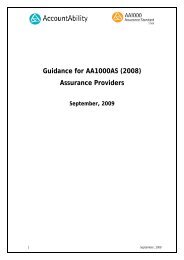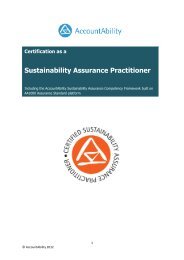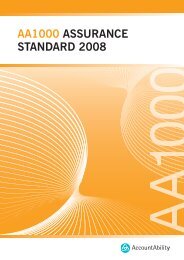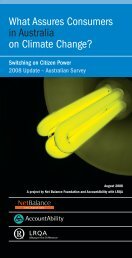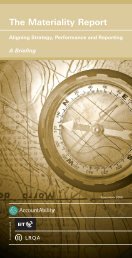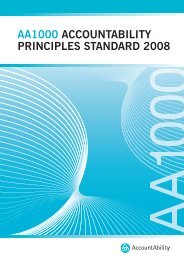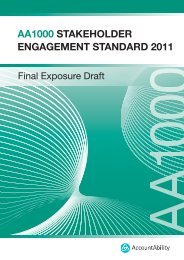The Stakeholder Engagement Manual Volume 2 - AccountAbility
The Stakeholder Engagement Manual Volume 2 - AccountAbility
The Stakeholder Engagement Manual Volume 2 - AccountAbility
Create successful ePaper yourself
Turn your PDF publications into a flip-book with our unique Google optimized e-Paper software.
P3: IDENTIFYING ISSUES<br />
A<br />
B<br />
C<br />
D<br />
E<br />
STAGE 1<br />
BACKGROUND<br />
Many issues you should consider engaging on will already be clear from the<br />
strategic engagement objectives discussed above. However, there are issues<br />
that may not be immediately strategically relevant, but nonetheless need to<br />
be identifi ed and addressed, as they also have the potential to impede business<br />
performance. In general, issues can be specifi c or general aspects of a companies<br />
activities or decisions where:<br />
– Th e organisation is perceived to have a positive or negative impact on<br />
stakeholders.<br />
AND<br />
– Th ere is a gap between what the company is doing or perceived to be doing,<br />
and what stakeholders expect the company to be doing in terms of<br />
management of impacts, behaviour or outcomes.<br />
Th is range of relevant issues goes beyond the limited defi nition of materiality<br />
used in fi nancial accounting standards, which are often interpreted conservatively<br />
to mean only those issues that are likely to have a measurable short-term<br />
impact on the fi nancial health of an organisation. Th is defi nition of materiality<br />
does not consider broader economic, social, environmental issues and leaves<br />
the organisation open to unanticipated risks and unable to identify new<br />
opportunities. On the other hand without some way of assessing the importance<br />
of diff erent issues to corporate performance, stakeholder engagement risks getting<br />
caught up by the short-term dynamics and moods of public opinion.<br />
A key challenge then is to identify those issues which are material to the business’s<br />
long-term sucess. Accountability's approach to assesing materiality is described<br />
below.<br />
5-Part Materiality Test<br />
<strong>AccountAbility</strong> has developed a fi ve-part materiality test as a framework for<br />
considering the materiality of issues. 5 Issues are considered material if they can<br />
be identifi ed by one or more of the following tests:<br />
Issues that have direct short-term fi nancial impacts<br />
Issues where the company has agreed policy statements of a strategic nature – these are<br />
often in the form of commitments to key stakeholders.<br />
Issues that comparable organisations consider within their sphere of materiality; i.e. peerbased<br />
norms.<br />
Issues that your stakeholders consider important enough to act on (now or in the future).<br />
Issues which are considered social norms (as indicated by regulations, likely future<br />
regulation or institutionalised norms and standards).<br />
5 For further explanation, please see <strong>AccountAbility</strong> & <strong>The</strong> UK Social Investment Forum: “Redefi ning Materiality”, London, 2003<br />
THE PRACTITIONER'S HANDBOOK ON STAKEHOLDER ENGAGEMENT | 35



